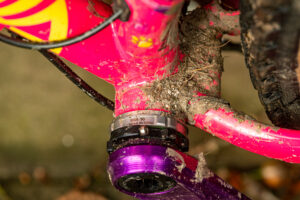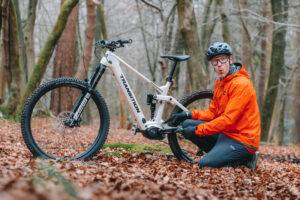Protect those pinkies and insulate your palms with a pair of our recommended winter riding gloves.
The body doesn’t work in mysterious ways, when it gets cold the vessels that supply blood to the skin constrict in a reaction called vasoconstriction. This helps minimise heat loss by pushing blood into the deeper tissues, but it is one of the reasons your hands feel cold in the winter. The other is the lower temperatures and wind chill, and if it’s wet it just makes things worse. To stop cold hands you can’t rely on one of the best gloves for mountain biking; you need a top winter riding glove. Read on to find out which ones we recommend after many cold, wet rides trying out all the options on the market.

The 100% Brisker glove is a winter essential.
1. 100% Brisker Cold Weather
Winter warmth with summer dexterity
Colours: Black, fluo orange, fluo yellow, white, camo, grey, neon pink | Sizes: S-XXL | Rating: 10/10
Reasons to buy:
- Amazing glove at a great price
- Unimpeded dexterity, yet toasty warm
Reasons to avoid:
- Not fully waterproof
- Needs to be under 5ºC or they’re too hot
The Brisker glove from 100% sets the bar when it comes to a winter glove. It’s not fully waterproof and is only padded on the upper but it stays toasty warm even when wet. Where it scores just having an amazing amount of feel for a winter glove, normally you’d lose a lot of sensitivity but the Brisker has that in spades.
There’s a thumb wipe for mopping up drool and while the short cuff doesn’t really tuck that far under a jacket sleeve, this glove is toasty warm. It’s available in even colours, six sizes and a long-cuff version called Hydromatic with a waterproof inner, and there’s even a women’s version. On top of all that it’s an absolute bargain and is even undercuts most summer gloves.
Read our full test review of 100% Brisker Cold Weather gloves
2. Fox Ranger Fire glove
Toasty alternative from the mighty Fox head
Colours: Black, fluo | Sizes: S-XXL | Rating: 9/10
Reasons to buy:
- Better for Baltic temps than the 100% Brisker.
Reasons to avoid:
- Not quite as dexterous as the Brisker.
The Fox Ranger Fire is an insulated glove with a water resistant coating and extended cuff to seal in the warmth. We found it was nicely articulated to our hand shape and finger length when holding the bar. While the fit was snug, with an unobtrusive palm feel and solid grip connection. That weatherproof outer fabric feels a bit like neoprene feel and proved effective at fending off cold winds and driving rain. They do get warmer than the 100% Brisker, which means you might not get as much use out of them in the UK climate.
Read review of the Fox Ranger Fire Gloves

Madison Zenith 4-Season DWR is a decent winter glove at a good price.
3. Madison Zenith 4-Season DWR glove
Excellent winter glove for UK riders
Weight: 66g | Sizes: M – XXL | Rating: 8/10
Reasons to buy:
- Designed in the UK – and the details show.
Reasons to avoid:
- Not available in smaller sizes.
UK company Madison’s brand new DTE 4-Season DWR is a windproof glove with a thin palm and incredible feel. It’s a single-shell design but it does come pre-shaped to cut down on the bunching when gripping the handlebar. It’s a little longer than the 100% Brisker in the cuff and there’s only a pull tag on the neoprene cuff reducing bulk in this area. The DTE is only windproof and breathable, but it does have a quality DWR coating to help water pool on the surface and run off in a sudden downpour. Comes with a large soft sweat wipe, if things hot up.
There’s a ton of feel from the synthetic palm and small areas of silicone grp on the fingers and thumb improve the grip in wet weather. Available in six sizes and two colours, at this price, it’ll definitely give the Brisker a run for its money.
Read our full test review of the Madison Zenith 4-Season DWR

The Alpinestars WP glove is a real winter warmer.
4. Alpinestars Tahoe Wp
Best for full waterproofing
Weight: N/A | Sizes: S – XXL | Rating: N/A
Reasons to buy:
- Keeps you toasty on the worst winter days.
Reasons to avoid:
- Bulky and expensive.
The Alpinestars Tahoe is a fully waterproof glove with a multi-panel construction, which adds articulation to the back of the hand and fingers. It’s bulky and the fit is tricky to get right but it does feature a stretch panel between the thumb and forefinger to improve fit. The plush padding on the fingers and upper makes this the perfect choice for those sub-zero rides. It gets a synthetic suede palm, which is waterproof, durable and has a surprisingly nice feel despite being double-layered. The back of the glove has rip-stop Nylon construction, so you’re not going to put a hole in it if you end up in the brambles. It also has a touch screen compatible finger, so you can check the route or take a selfie without having to take the glove off.
How we test
Testing winter equipment is not nice, we have to get out in the crappy weather and use it inappropriately to really gauge its effectiveness. That means riding on the moors and high hills in the worst type of weather with one brand of glove on one hand and another brand on the other. We swap gloves to compare their windproof/waterproofness and also get them wet to see if they are fully waterproof.
We also wash all the gloves several times because that special DWR (durable water repellent) coating that helps pooling can wash off. Long-term durability with thickly padded gloves is also important because they can wear excessively on the palm and seams and even split at the cuff when we’ve pulled them on repeatedly.
Sizing is also a key issue with a padded mitt and if the glove comes up small or large we’ll let you know. Also, does price go hand in hand with quality? You’d think so, but not always.
What to look for in a winter glove for mountain biking
Winter gloves come in two types – windproof and waterproof, although the latter also covers both duties. A windproof glove either has a windproof membrane covering the top of the hand or has thicker padding. In both cases it’s attempting to do is cut down on wind chill, which can make your hands feel much colder than the ambient temperature. There’s a chart available showing the ratio, but essentially the faster the wind blows (and that includes you riding into it) the colder you’ll feel.
A waterproof glove has a similar high-tech membrane, but it’s often wrapped around the whole of your hand – think of this as a glove inside a glove. This membrane will be waterproof, breathable and have taped seams but the glove may also be heavily padded to add warmth. The downside of all this is bulk is a lack of feel, and also higher a cost.
Your choice of winter glove will be dependent on the local trail conditions, altitude, wind chill and how hard you’re riding. For example, if you’re riding hard and generating a lot of heat then you may not need a heavily padded glove. The good news is there are loads of winter gloves on the market for most condition and rider types.
What is a DWR coating?
Most winter gloves should have a DWR (durable water repellent) coating, which is an ultra-thin polymer that’s sprayed onto the outermost fabric layer. It’s not waterproof in itself, but it does force water droplets to pool on the surface where they can merge together and run off – think of it as the first line of defence. The problem with DWR is dirt can impair its effectiveness and it can wear and wash off, so you need to renew it regularly.
How much heavier is a winter glove?
Due to the thicker construction a winter glove is often twice the weight of a summer glove but it’s more likely to get wet and that adds weight too. Keeping the DWR treatment renewed stops water from soaking into the fabric and also allows the glove to breath.
How useful is a long Cuff?
To provide maximum protection winter gloves generally have a longer cuff. On some, this is just an extension of the base material but others have a fleecy cuff that tucks under your jacket sleeve to create a weather-proof seal.
What material is used in the palm?
Most winter gloves use a synthetic leather palm, which is made using natural or synthetic fibres, which are then coated with a plastic polymer. This makes it washable; it doesn’t crack or fade and it’s obviously much cheaper and greener than real animal hide. The best gloves are single-layered but some are double-skinned, which adds warmth but can cut down on the all-important feel.
What is a waterproof membrane?
Usually this is a Gore-Tex or a branded membrane with a similar wicking and waterproof quality. The seams will be taped with a sticky version of the base material to stop water ingress. The membrane should extend all to the end of the glove but sometimes it doesn’t.
How important is dexterity?
For some riders, feel is king but you may need to compromise slightly with a winter glove. A full membrane is going to add quite a bit of extra thickness to the palm and even the padded windproof gloves are thicker in this area. Some winter mitts also have extra reinforcement around the thumb/finger crease and when you grip all that material bunches up. Add in mud and wet and you can feel less connected, but that’s the price you have to pay for warm hands.

















